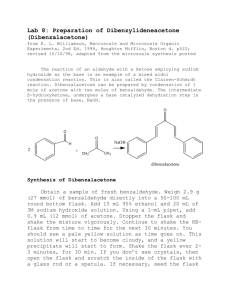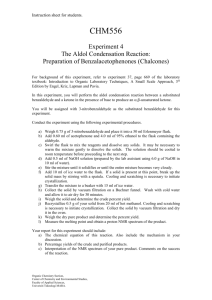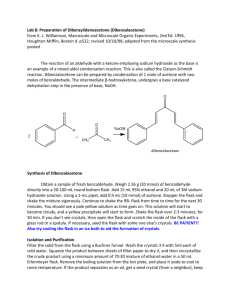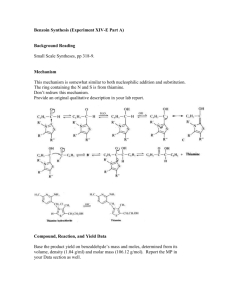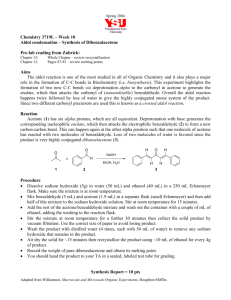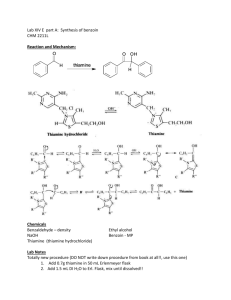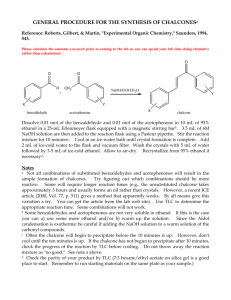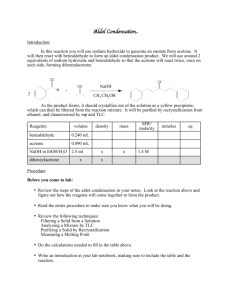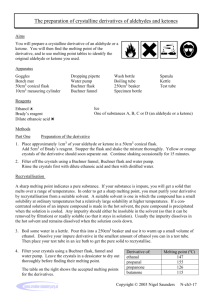The reaction of an aldehyde with a ketone employing sodium
advertisement
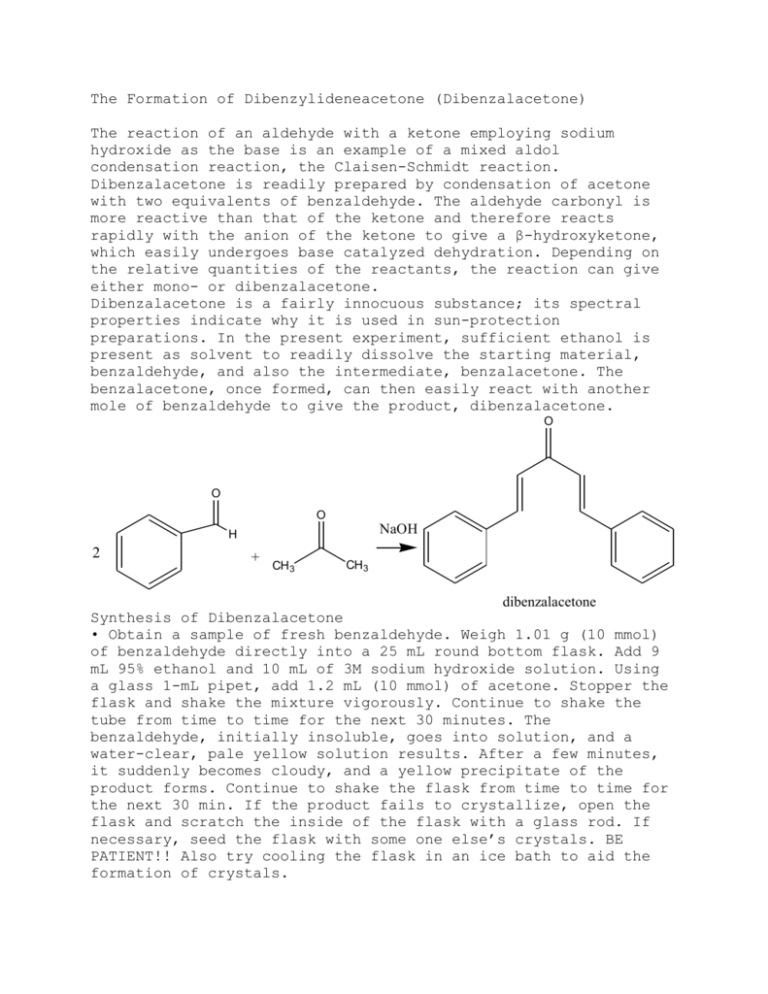
The Formation of Dibenzylideneacetone (Dibenzalacetone) The reaction of an aldehyde with a ketone employing sodium hydroxide as the base is an example of a mixed aldol condensation reaction, the Claisen-Schmidt reaction. Dibenzalacetone is readily prepared by condensation of acetone with two equivalents of benzaldehyde. The aldehyde carbonyl is more reactive than that of the ketone and therefore reacts rapidly with the anion of the ketone to give a β-hydroxyketone, which easily undergoes base catalyzed dehydration. Depending on the relative quantities of the reactants, the reaction can give either mono- or dibenzalacetone. Dibenzalacetone is a fairly innocuous substance; its spectral properties indicate why it is used in sun-protection preparations. In the present experiment, sufficient ethanol is present as solvent to readily dissolve the starting material, benzaldehyde, and also the intermediate, benzalacetone. The benzalacetone, once formed, can then easily react with another mole of benzaldehyde to give the product, dibenzalacetone. O O O NaOH H 2 + CH 3 CH 3 dibenzalacetone Synthesis of Dibenzalacetone • Obtain a sample of fresh benzaldehyde. Weigh 1.01 g (10 mmol) of benzaldehyde directly into a 25 mL round bottom flask. Add 9 mL 95% ethanol and 10 mL of 3M sodium hydroxide solution. Using a glass 1-mL pipet, add 1.2 mL (10 mmol) of acetone. Stopper the flask and shake the mixture vigorously. Continue to shake the tube from time to time for the next 30 minutes. The benzaldehyde, initially insoluble, goes into solution, and a water-clear, pale yellow solution results. After a few minutes, it suddenly becomes cloudy, and a yellow precipitate of the product forms. Continue to shake the flask from time to time for the next 30 min. If the product fails to crystallize, open the flask and scratch the inside of the flask with a glass rod. If necessary, seed the flask with some one else’s crystals. BE PATIENT!! Also try cooling the flask in an ice bath to aid the formation of crystals. Isolation and Purification Decant the liquid from the flask using a Hirsch funnel. Add 5 mL of cold water and shake the flask vigorously. Collect the wash with the Hirsch funnel and rinse the crystals 2 X more with 5 mL portions of cold water. Squeeze the product between sheets of filter paper to dry it, and then recrystallize the crude dibenzalacetone from 70:30 ethanol water. Insert a boiling chip to promote even boiling. Remove the boiling solution from the hot sand bath, and place it in a beaker of glass wool to insulate it so it cools slowly to room temperature. Should the product separate as an oil, try to obtain a seed crystal, heat the solution to dissolve the oil, and add the seed crystal as the solution cools. If it continues to oil out, add a bit more ethanol. Collect the product on the Hirsch funnel or by removing the solvent with a pipette after cooling the tube for several minutes in ice. Wash the crystals once with about 3 mL of ice-cold 70% ethanol while the tube is in ice. Dry the product under vacuum by attaching the tube to an aspirator for a few minutes. Determine the weight of the dibenzalacetone and its melting point, and calculate the percentage yield. In a typical experiment the melting point should range from l10.5 to 112°C. In the last step of the aldol condensation, loss of water from the β-hydroxyketone can form molecules in which the alkene hydrogen atoms are either cis or trans to each other. The name dibenzalacetone does not completely characterize the molecules made in this experiment. There are 3 isomeric dibenzalacetones, one melting at 100-110 °C, λmax 330 nm, ε 34,300; another melting at 60 °C, λmax 295 nm, ε 20,000; and a third, a liquid with λmax 287 nm ε 11,000. Both the melting points and the UV spectral data give some hints regarding the structures of these molecules. The first one is very symmetrical and can pack well into a crystal lattice. The long wavelength of the ultraviolet light absorption maximum and the high value of the molar absorbance ε indicate a long, planar conjugated system. The other two molecules are increasingly less able to pack nicely into a crystal lattice or to have a planar conjugated system. In your Final Report, include the structures of the three geometric isomers of dibenzalacetone (cic,cis; cis,trans; trans,trans), and assign each one to the three molecules described in the previous paragraph. Post Lab Questions 1. Why is the C=O peak showing up at lower wavenumbers (1639 cm1) than standard C=O frequency (1715 cm-1)? 2. How would you change the procedures in this experiment if you wished to synthesize benzalacetone, C6H5CH=CHCOCH3? Benzalacetophenone, C6H5CH=CHCOC6H5? 3. Write the detailed mechanism for the formation of dibenzalacetone from benzalacetone and benzaldehyde. 4. The product formed has a pale yellow color. Why?
